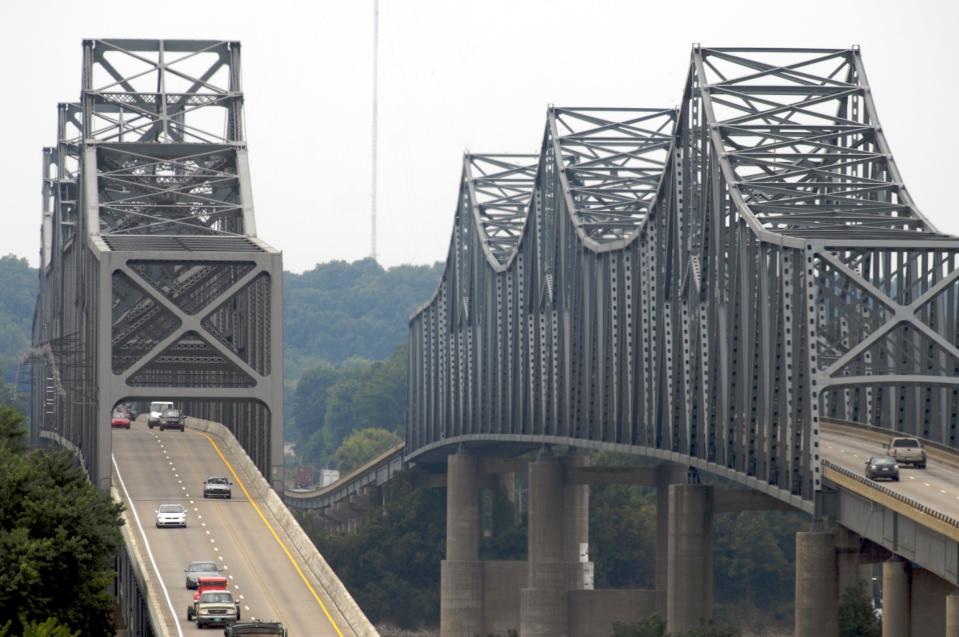Lengthy lane closure coming to U.S. 41 southbound Twin Bridge
Driving from Evansville to Henderson could be a little tricky over the next couple of months.
The southbound U.S. 41 Twin Bridge will be down to one lane from this Monday (Sept. 25) through Nov. 18 for a special extended inspection to assess the structural integrity and safety of the bridge, the Kentucky Transportation Cabinet announced.
Additionally, KYTC will restrict all truck traffic to a maximum width of 12 feet, prohibiting wide loads during the testing period.
“Motorists should anticipate delays and potential traffic backups due to lane closures and restrictions,” a cabinet news release stated, a warning that won’t surprise motorists familiar with how lane closures and merging vehicles can snarl traffic on the Twin Bridges, which combined carry an average of 41,375 vehicles each day.
Over the next seven weeks, a contractor will be removing paint, testing hundreds of welds and then reapplying primer.

The federally mandated testing has been triggered by the discovery of fractures in butt welds on at least two interstate bridges that, like the southbound Twin Bridge, were constructed in the 1960s and 1970s and contain “T-1” steel.
In 2011, an inspection revealed several cracks in butt welds on the Interstate 64 Sherman-Minton Bridge that carries six lanes across the Ohio River between Louisville, Kentucky, and New Albany, Indiana. That resulted in the closure of the double-deck span for five months so repairs could be made.
“It was subsequently determined that the cracking was very likely caused by hydrogen that was introduced into the weld as the result of inadequate fabrication procedures,” according to a Federal Highway Administration (FHwA) memo.
Then, on May 11, 2021, a fracture was discovered in a butt weld on the I-40 bridge across the Mississippi River between Memphis, Tennessee, and West Memphis, Arkansas. The bridge was immediately closed to ensure safety. Subsequent testing found 12 other butt weld fractures related to hydrogen cracking on the I-40 bridge that couldn’t be detected through a visual inspection. That bridge remained closed for 2½ months while repairs were made.
In December 2021, the FHwA issued a memo mandating states to identify, inspect and test specific T-1 steel bridges to verify the soundness of all butt welds with the use of non-destructive testing by March 31, 2024.
Michael Baker International, an engineering firm instrumental in the emergency repair of the Interstate 71/Interstate 75 Brent Spence Bridge between Covington and Cincinnati following a fire in 2020, will lead the inspection and testing of the southbound Twin Bridge.
KYTC described “T-1” steel as “a grade of high-strength, quenched and treated steel known for being highly amenable to welding and machining.” But it’s critical that welds are sound, including for butt welds where two pieces of steel are joined end-to-end without overlapping.
New standards for welding on steel bridges were established in 1978 and again in 1995 “to ensure proper welding procedures and post-welding testing to prevent defects like hydrogen cracking from being inadvertently incorporated into an in-service highway bridge,” the FHwA’s 2021 memo declared.
The I-64 Sherman Minton Bridge (built in 1960-61), I-40 bridge at Memphis (1973) and U.S. 41 southbound Twin Bridge (1965) were all constructed before those standards went into effect. (The U.S. 41 northbound Twin Bridge was constructed in 1932.)
KYTC noted that all structures carrying public roads in the United States undergo a routine inspection every 24 months. For certain spans, like the Twin Bridges, a hands-on inspection of critical members is also performed. This biennial inspection was completed on the U.S. 41 southbound bridge in August 2022. That inspection report contained no critical findings for the southbound bridge, which was built in 1965. The upcoming testing is intended to confirm the soundness of butt welds on the three-span cantilever truss bridge, which extends just over one mile.
The scheduled completion date of Nov. 18 for the testing would fall just ahead of the heavy Thanksgiving travel time.
This article originally appeared on Evansville Courier & Press: Lengthy lane closure coming to U.S. 41 southbound Twin Bridge

